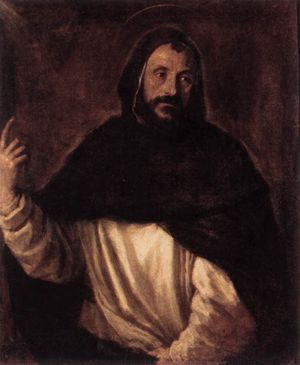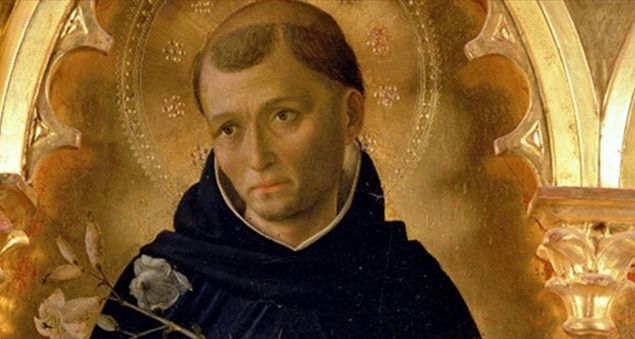The founder of Preachers friars He was born in 1170 in Caleruega, Castile, from Felice of Guzmán and Giovanna D’Aza, even if there are no certain testimonies that descends from the noble family of Guzmán. After a first education received by an Archpriest uncle, he was sent to Palencia over 14 years old where he attended regular liberal and theology arts courses, for a decade. In contact with the miseries caused by continuous wars and famines, he showed a great charity towards the poor, arriving in 1191 to sell his precious parchments to feed them. After his studies, at 24 he entered the regular canons of the Cathedral of Osma and was ordained a priest. Regular life, choral liturgy and contemplation experiences perfected his training.
Blessed Angelico, San Domenico in prayer
The mission between the heretical movement of the Càari
The decisive event for him was when the bishop Diego di Acebesin 1203, sent on a diplomatic mission to Denmark by King Alfonso VIII of Castile to escort a promised printed bride of a Spanish prince, asked Domenico to accompany him. During the journey, both came in contact with two great dangers for the Christianity of that time: the heretical movement of the Càari (Albigesi), spread above all in southern France, and the strong pressure of the pagan populations of northeastern Europe, including that of the Cumani whose raids had terrified northern Germany. Back from a second trip to Denmark, Diego and Domenico went down to Rome to ask Innocenzo III to devote himself to the evangelization of the pagans, but the pontiff oriented them towards preaching in the south of France among the càari. Thus, in 1206, they went as missionaries in LinguaDoca and there Domenico continued his apostolate even after Diego’s sudden death, which took place on 30 December 1207.
The appearance of the Virgin of the Rosary
The heretics, preaching and giving the example of an austere and poor life, had a good game on the people because of the luxury, ignorance and sometimes of the dissolute life of the clergy, substantially contrary to the reform desired in the 11th century by Pope Gregory VII. To win, the Càari on their own ground, associating poverty and austerity of life with preaching; So they had already begun to make Diego and Domenico who then hidden his apostolate on public debates, personal interviews, negotiations, preaching, persuasion, prayer and penance supported by the bishop of Toulouse, Folco di Marseille. Also in Linguadoca, in Prouille, he had founded a monastery in which women who had abandoned catarism were welcomed; Meanwhile, around him, men who shared his own ideals had also gathered, and with them he matured the idea of giving the preaching of the group a stable and organized form.
During his stay in Toulouse, as the blessed Alano of the Ripe tells us, Domenico had a vision of the Virgin Mary who gave him the rosary Like the most effective prayer to combat heresies without violence. Since then, the Rosary spread to become one of the most traditional Marian prayers. Together with Folco in October 1215 Domenico took part in Rome at the Lateran Council IV and subjected his project to Innocent III who approved him. The following year, on December 22, it was the successor, Honorius III, who gave the official and definitive approval to what was called “Order of preachers“.

Tiziano, San Domenico di Guzmán, about 1565
The order: study, poverty, preaching, common life
Pontifical recognition favored rapid growth of vocations and as early as 1217 the order was able to send friars to various regions of Europe, especially in the Iberian peninsula and in the main university centers of the time, in Paris and Bologna. There was no lack of oppositions from the local bishops, who however were overcome by a papal bubble dated 11 February 1218, who ordered all the prelates to give assistance to the preachers. In 1220 and 1221 Domenico chaired in Bologna the first two general chapters intended to draw up what can be called the Magna Charta of the Order, in which the fundamental elements are specified, namely: preaching, study, beggar poverty, common life, legislation, geographical distribution and missionary expeditions. In particular, the study had to exercise “day and night”. “At home and traveling”, as a half ascetic and in view of a more effective preaching.
The Chapel of San Domenico in the Basilica of the same name in Bologna
From 1267 the relics kept in Bologna
After the second general chapter, Domenico resumed the Annatara mission especially in the Veneto and in the Marche with a group of teammates from the Pope, and with the help of Cardinal Ugolino, bishop of Ostia, he founded other convents in Brescia, Piacenza, Parma and Faenza. But the effort and the heat broke its fiber already exhausted by the continuous penances (did not eat meat and did not drink wine), forcing him to return to Bologna where he died on August 6, 1221, surrounded by his friars to whom he had turned the exhortation “to have charity, to keep humility and to own a voluntary poverty”.
An iron chain was found around his hips. As already alive, even after death numerous miracles occurred by the intercession of Domenico, but his confreres, contrary to what the minor friars had done for St. Francis, did not encourage the incipient worship at all, indeed they hindered him, even reaching him to remove and break the ex vote to prevent the flow of pilgrims to prevent their ministry. Cardinal Ugolino, who became Pope Gregory IX to the death of Honorius III, replied them for this and on July 3, 1234 he cannon Domenico in Rieti. From 1267 the relics of the saint are venerated in Bologna in the basilica dedicated to him; The ark that contains them, carved by Niccolò Pisano, has been enriched over the centuries of splendid additions of important artists (including Michelangelo). In Rome, in the cloister of the convent of Santa Sabina sull’Aventino, an orange plant is still present which, according to tradition, San Domenico brought from Spain. The popularity of the saint, also for the spread of his order, was immense, and very numerous the places that wanted him as a protector; For Italy, just remember Bologna (of which he was proclaimed “patron and perpetual defender of the city”) and Naples. On the occasion of the VII centenary of his death, on June 29, 1921 Pope Benedict XV dedicated the encyclical to him FAUSTO Appeal die.


